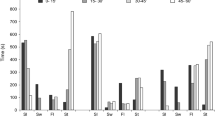Abstract
Toosendanin, a tetranortriterpenoid isolated from the bark of Melia toosendan, is a feeding deterrent for larvae of Pieris brassicae. By using electrophysiological techniques, it was found that toosendanin stimulates a deterrent receptor cell located in the medial maxillary sensillum styloconicum. Toosendanin also inhibits responses of both the sugar and glucosinolate receptor cell, which are localized in the lateral sensillum styloconicum. The degree of inhibition of the sugar receptor increases with increasing sucrose concentration. The glucosinolate receptor cell shows a reversed reaction: inhibition by toosendanin decreases with increasing sinigrin concentration. Inhibitory effects occur at a toosendanin concentration as low as 10−9 M and are dose dependent. The taste neurons that respond to amino acids or deterrents in the lateral sensillum, however, are not affected by toosendanin. It is concluded that the sensory code underlying feeding behaviour is modulated by toosendanin via several different peripheral sensory mechanisms.
Similar content being viewed by others
References
Blom F (1978) Sensory activity and food intake: a study of input-output relationships in two phytophagous insects. Neth J Zool 28: 277–340
Chiu Shin-Foon (1989) Studies on plants as a source of insect growth regulators for crop protection. J Appl Entomol 107: 185–192
Dethier VG (1982) Mechanism of host-plant recognition. Entomol Exp Appl 31: 49–56
Dethier VG, Bowdan, E (1992) Effects of alkaloids on feeding by Phormia regina confirm the critical role of sensory inhibition. Physiol Entomol 17: 325–330
Hirao T, Arai N (1991) On the role of gustatory recognition in host-plant selection by the silkworm, Bombyx mori L. Japan J Appl Entomol Zool 35: 197–206
Hodgson ES, Lettvin JY, Roeder KD (1955) Physiology of a primary chemoreceptor unit. Science 122: 417–418
Ishikawa S 1966 Electrical response and function of a bitter substance receptor associated with the maxillary sensilla of the larva of the silkworm, Bombyx mori L. J Cell Comp Physiol 67: 1–12
Jacobson M (1988) The neem tree. CRC Press, Boca Raton, Fl
Jermy T (1966) Feeding inhibitors and food preference in chewing phytophagous insects. Entomol Exp Appl 9: 1–12
Loon JJA van (1990) Chemoreception of phenolic acids and flavonoids in larvae of two species of Pieris. J Comp Physiol A 166: 889–899
Loon JJA van, Eeuwijk FA van (1989) Chemoreception of amino acids in larvae of two species of Pieris. Physiol Entomol 14: 459–469
Luo Lin-Er, Liao Chun-Yan, Zhou Pei-Ai (1989) Electrophysiological study of the antifeedant action of toosendanin to the armyworm larvae. Acta Entomol Sinica 32: 257–262
Ma WC (1969) Some properties of gustation in the larva of Pieris brassicae. Entomol Exp Appl 12: 584–590
Ma WC (1977) Alterations of Chemoreception function in armyworm larvae (Spodoptera exempta) by a plant-derived sesquiterpenoid and by sulfhydryl reagents. Physiol Entomol 2: 199–207
Mitchell BK (1987) Interactions of alkaloids with galeal chemosensory cells in the adult Colorado potato beetle, Leptinotarsa decemlineata. J Chem Ecol 13: 2009–2022
Monod J, Wyman J, Changeux JP 1965 On the nature of allosteric transitions. J Mol Biol 12: 88–118
Schoonhoven LM (1969) Amino-acid receptor in larvae of Pieris brassicae (Lepidoptera). Nature 221: 1268
Schoonhoven LM (1977) Insect chemosensory responses to plant and animal hosts. In: Shorey HH, McKelvey JJ (eds) Chemical control of insect behavior. J. Wiley, New York, pp 7–14
Schoonhoven LM (1981) Perception of azadirachtin by some lepidopterous larvae. In: Schmutterer H, Ascher KRS, Rembold H (eds) Proc 1st Int Neem Conf, Rottach-Egern 1980, pp 105–108
Schoonhoven LM (1987) What makes a caterpillar eat? The sensory code underlying feeding behavior. In: Chapman RF, Bernays EA, Stoffolano JG (eds) Perspectives in chemoreception and behavior. Springer, New York, pp 69–97
Schoonhoven LM, Yan Fu-Shun (1989) Interference with normal chemoreceptor activity by some sesquiterpenoid antifeedants in a herbivorous insect Pieris brassicae. J Insect Physiol 35: 725–728
Schoonhoven LM, Blaney WM, Simmonds MSJ (1992) Sensory coding of feeding deterrents in phytophagous insects. In: Bernays EA (ed) Insect-plant interactions. CRC Press, Boca Raton, 4: 59–79
Shu GX Liang XT (1980) A correction of the structure of chuanliansu (Toosendanin). Acta Chim Sin 38: 196–198 (in Chinese)
Simmonds MJ, Blaney WM (1984) Some neurophysiological effects of azadirachtin on lepidopterous larvae and their feeding response. In: Schmutterer H, Ascher KRS (eds) Proc 2nd Int Neem Conf, Rauischholzhausen 1983, pp 163–180
White PR, Chapman RF, Ascoli-Christensen A (1990) Interactions between two neurons in contact chemosensilla of the grasshopper, Schistocerca americana. J Comp Physiol A 167: 431–436
Author information
Authors and Affiliations
Rights and permissions
About this article
Cite this article
Schoonhoven, L.M., Lin-er, L. Multiple mode of action of the feeding deterrent, toosendanin, on the sense of taste in Pieris brassicae larvae. J Comp Physiol A 175, 519–524 (1994). https://doi.org/10.1007/BF00199258
Accepted:
Issue Date:
DOI: https://doi.org/10.1007/BF00199258




